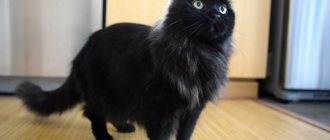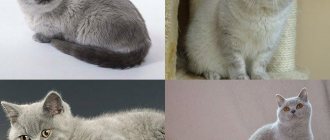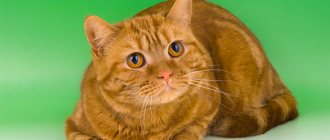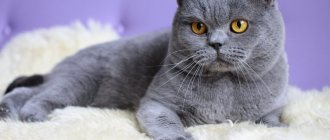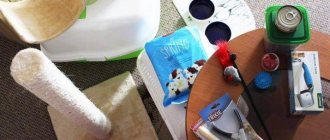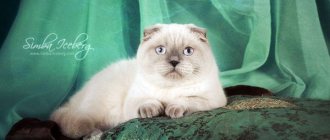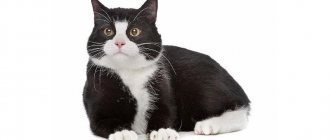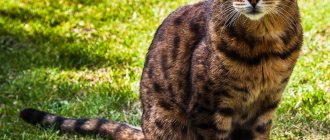All cats of the British breed can be divided by color into 6 groups (solid, tabby, smoky, tortoiseshell, bicolor and color point). Animals with a marbled coat have appeared recently and are part of the tabby group. Until now, they have not become stable in breeding, and therefore are considered rare and expensive.
Let's find out how the British merle coat differs from other representatives of this breed.
Features of color and types
All cats are tabby or spotted, but not all have this pattern visible. Even black animals have the same stains on their fur. The British merle color fully complies with this rule.
- Brindle. The most common type is when a pattern of thin stripes is visible on the surface of the coat. The symmetrical lines of the “necklace” converge around the neck, “ribs” are drawn from the spine to the stomach, and 5-7 narrow rings are placed on the tail. The conventional repetition of the tiger skin pattern gives this color its name.
- Spotted (leopard). It is characterized by broken lines in the form of spots of various lengths and configurations. They do not form a clear pattern and appear in fragments: the “necklace” is more likely to be guessed, a line of spots stretches between the withers and the base of the tail, and a row of “buttons” appears on the belly.
- Abyssinian ticked. Here there is no pattern at all, and it is replaced by small ripples (freckles) on the fur. Residual striping is allowed only on the paws and tail, and the “necklace” on the neck has an open appearance.
- around the neck are the lines of a massive necklace;
- There are three wide strokes from the neck to the tail;
- the tail is ringed 3-5 times;
- large “buttons” along the belly.
All of the listed colors are inherent in the breed of British cats - about 250 different colors are allowed in a single color or in combinations.
Marbled cats have a pattern similar to a tiger cat, but with a significant addition: the lines are wider and clearer. There is a “butterfly” visible on the back, and large rosettes on the sides – “eyes”.
British marbled cats are presented in 4 types and the color designation in them depends precisely on the color of the lines.
These colors are found in marbled British cats. Chocolate, cinnamon, lilac and fawn, allowed in other populations, are prohibited for aboriginal cats.
The next subspecies of merle color concerns two-color tortoiseshells. This coloring occurs when there is a combination of the dominant and recessive red gene Oo in the cat’s genotype. It is absolutely characteristic of marbled British girls, as it joins two female X chromosomes.
This process should be considered in more detail on red colors, and for the overall picture only one note is important - tortoiseshell marbled kittens are represented exclusively by the female sex.
Male cats can acquire a similar coloring in one case - if they have an extra X chromosome, which automatically classifies the animal as infertile.
“Turtles” are distinguished by a more complex genetic formula of marbled color and among the British they are presented in only 2 colors: black and blue. All other combinations (chocolate, cinnamon, lilac and fawn) indicate interbreeding and are mercilessly fined at exhibitions.
It is important! All marbled British cats have a common feature - a large letter M on their forehead. There are various legends about her appearance - either Mohammed took her in his arms, or Magdalena tried. But it is unlikely that these fairy tales have anything in common with the truth - natural nature is much more diverse than one can imagine.
Types of colors
British tabby cats have light, muted tones as their main color. The drawing has a dark color that contrasts with the main one.
Lilac
The main color of the Briton is beige with a hint of purple markings. A special feature is the pink nose and pads on the paws, which look very gentle.
Silver
The British silver tabby cat has a delicate bluish tint. The pads on your pet's paws may have the same shade or pinkish.
Gold
The main shade is gold, and the pattern on the body is made in various coat colors several shades darker. Golden tabby is divided into several more types of color: black, blue, chocolate (brown) and color-point.
Blue
The main color of cats is a light blue tint, including not only the fur, but also the nose and paw pads. The color is interesting because it is dominant: when the offspring appear, most of the kittens will have exactly this color. A dark blue pattern is observed throughout the body.
Red
On the body, the main shade of which is cream or silver, there is a pattern of bright orange color (compared to a red sunset).
Genetics of merle color and the history of its appearance
To obtain the color, interbreed matings of English cats with Persians and exotics were used. Outwardly, they are very similar to the British, so they did not spoil the breed, but only transferred the genetic properties of the color. There are known cases of Egyptian Mau and even American smooth-haired animals being included in the process.
Later, when a large group with the required color parameters had gathered, extraneous animals were excluded from the breeding program.
The main phase of selection took place almost a century ago, so by now the marbled ones have already been thoroughly studied, and nurseries from generation to generation are guaranteed to receive the required color.
It is necessary to begin studying the process with the tabby trait, which forms any pattern on the coat.
Another gene is agouti (A), which performs two functions. In the dominant form, it opens the way for the tabby pattern, and in the recessive combination (aa) it suppresses T and the color in cats becomes solid. It is clear that all British shorthaired harlequins have a dominant variant A in their genetic code.
There are objective indicators that worsen the quality of color:
- excessive contrast between the pattern and the background fur;
- pattern blurred by ticking;
- broken stripes that do not form a continuous line;
- a drawing stroke that is too thick and overly covers the main tone.
It is important! The coat pigmentation of British harlequins can vary. In the main areas it is uneven and depends on the density of the capsules with the dye (eumelanin or pheomelanin) in the hair. In the drawing area, each hair is filled with pigment equally from root to tip, which provides a contrasting and rich color.
Differences between merle and other tabby colors
All differences in color combinations are only in the plane of visual perception of the combinations. Because of their wide lines and larger pattern, marbled tabbies are superior to brindle and leopard tabbies.
And when tortoiseshell two-color combinations come into play, the number of combinations cannot be counted. Standard tabbies cannot provide such characteristics, which does not prevent them from creating their own unique color compositions.
This is interesting! Although the merle color was introduced into the British breed later than others, it was designated as “classic” for cats of the British breed.
Types of drawings
Tabby is not one specific pattern, as many people believe. There are several varieties of it, and all are considered standard. The pattern appears due to the A gene (agutti). A British female with the color formula “AA” gives birth to only patterned kittens, and with “Aa” the ratio of patterned kittens to plain ones is 50%. Cats with the formula “aa” will be monochromatic.
There are four main types of tabby patterns: ticked, striped, marbled, spotted.
Ticked (Abyssinian)
At first glance, it may seem that the British ticked coat is a solid color, but this is not the case. The color of their coat is not at all uniform: the whole body has barely noticeable stripes, spots or specks (there are “freckles”), slightly darker than the main tone of the British. The tip of the tail is usually dark. Eyes are golden or green.
Striped, brindle (mackerel)
The British tabby cat is the most popular cat available. The second name appeared due to the similarity with the color of the mackerel fish. The pattern is characterized by frequent narrow, clear stripes throughout the body, especially along the ridge. British tabbys are characterized by necklace-like lines on the chest and a broken stripe on the forehead, reminiscent of the Russian letter “M”. The British cat's full brindle coloration develops by the age of one year.
Classic (marble)
One of the most favorite colors among breeders of this breed is the marbled tabby. It is visible already from the birth of the kitten, it may merge slightly, but by two months it has a clear pattern. The body is covered with wide ornate patterns with clear outlines on the back, sides and vague ones on the abdomen and paws. The color of the pattern contrasts with the main shade of the Briton’s body – a kind of marble on silver.
Spotted (leopard)
A cat of the British breed with this coloring is similar to a representative of the wild - a leopard, but in miniature. Wide stripes are intermittent and represent spots of various sizes. Eye color: copper, green.
False marbling or moire
Sometimes genetics plays a cruel joke on marbled cats - agouti (gene A) manifests itself not in a dominant, but in a recessive state.
The British merle cat produces offspring that in childhood are very similar to real representatives of their species. Only the lines in newborn kittens are more faded and blurred.
Conversations that in the future the moire will fade and the coloring will return to normal are carried out by complete ignoramuses in cat breeding or scammers. Over time, the false marble will not go anywhere, it will acquire a shade of the main color and remain that way for the entire cat's life.
There may be 1-2 false marbled animals in a litter. In the first case, it is very easy to identify a “defective” baby - he is clearly different from his brothers and sisters. And when 5-7 identical moire children are near a real marble cat-mother, you can easily make a mistake.
If there is the slightest doubt, experts have only one recommendation - it is best to go to another nursery and look at another litter. If the buyer is convinced of the identity of the kittens, then he can decide which breeder to purchase them from. And the probability of getting two completely moire marble offspring in practice is zero.
British merle color: features of the breed
The first cat show, held in 1879 in London, was attended by the British. Since then, plush animals have gained considerable popularity, as kittens were actively bought by foreign breeders and taken outside the country. The breed, despite its long existence, was officially recognized only in 1950.
At the end of the 70s of the last century, a document was created prohibiting breeding them with any other felines. And in 1980, aristocrats received recognition from the FCA Association.
According to the standard, a purebred individual must have:
- Proportional, strong body with clearly developed muscles, squat and dense.
- Large head with wide-set, medium-sized ears (rounded tips).
- A fold around a short massive neck.
- Big round eyes. The color of the iris is predominantly amber-orange, less common is green and blue. Babies have gray-blue eyes, changing color as they grow older.
- Wide chest.
- Well-defined cheekbones, pronounced cheeks, developed chin and wide nose.
- Thick undercoat.
- The coat is short, dense with hairs of equal length. It feels like plush.
- Neat, strong, rounded paws corresponding to the body type.
- Fleshy, medium-length tail with a rounded tip and a wide base.
The British are distinguished by their long lives, often reaching 15-20 years of age. The weight of an adult animal ranges from 5 to 8 kg; height is not indicated in the standard, but must correspond to a dense constitution.
Marbled British Fold cats
A very common misconception that needs to be addressed. In fact, there are no marbled British Fold cats:
This is interesting! The Scots have all types of merle colors of their British ancestors and those that are prohibited to the aborigines: chocolate, lilac, fawn and cinnamon.
The Difficulties of Breeding British Marbleds
During pregnancy, which lasts 63 days, the cat should be fed well, but not allowed to overeat. Excess weight puts extra strain on the heart. Females usually give birth on their own. It is advisable for an inexperienced owner to agree in advance with the veterinarian about the possibility of a home visit in the event of an unforeseen complication.
Be sure to read:
British cat: character, care and maintenance, sterilization, when to vaccinate, feeding, what diseases they are susceptible to
Often, when crossing British cats, kittens are born that breeders, out of ignorance or for profit, sell as marbled, although in fact they are moire. It is easy to distinguish one from another. Tabbies are patterned in a color different from the main one, and moire specimens are painted in a darker shade of the “base”; over time they will become monochromatic.
How to get marbled kittens
A recessive gene is responsible for this color, so to get tabby kittens it is necessary to mate parents with the same coat.
A merle litter can be obtained from the mating of a spotted individual with a brindle, two brindles, or a pair of spotted ones if they both carry the recessive gene.
Character and habits of the marbled British and Scots
The differences in behavior and manners between the two English breeds are as significant as their external characteristics. Scientists reasonably question the influence of color at this point, although cat owners say that coat color and character still complement each other.
The British are touchy, proud, selfish. They prefer solitude and do not like to be the center of attention. Large companies make them wary, general games do not attract them, and English cats do not really like to communicate with their owner.
However, Britons can be good companions and grateful pets. To do this, you need to respect his personal space and discard the belief that the animal is obliged to do only what the owner tells him. Having thoroughly enjoyed the solitude, the Briton himself will want to express his gratitude and will find time to sit around people. Only this way, and no other way.
The Scottish branch is the exact opposite. Fold cats are sociable, kind, affectionate, and playful. They get bored alone, adore their owners and other family members, and get along well with any pet.
As for the influence of marble color on character, there are options:
- It is believed that black Britons are more cunning than cats of other colors.
- Redheads are prone to cunning, especially in adulthood, when they gain experience.
- The blue ones are the kindest of all, adjusted for their disposition. This means that they can tolerate familiarity longer, but their patience is not unlimited.
Experts have a more specific opinion about Scottish Fold cats - they are affectionate and sociable, regardless of color.
Characteristics of the Marble Briton
Experienced breeders rarely talk about the dependence of a cat’s character on its color. Some inexperienced owners may mistakenly consider Marbled Britons to be a different breed. However, these cats are British, which means they have all the character traits of this breed. They are smart, aristocratic, and wary of strangers. In addition, they are independent and self-sufficient and need human society less than others.
Recommendations for care and maintenance
The rules for caring for the coat and maintaining a marbled British or Scotsman are the same as for other representatives of the English breed.
The British and Scots are unpretentious eaters, but capricious colors sometimes react to the diet.
With the main light color of merle colors, it is not recommended to get carried away with seafood, although cats love them very much. Excess iodine immediately covers the white areas with a yellowish tint, which will disappear as soon as the menu is balanced.
Trace elements of copper give a reddish tint, and excessive consumption of poultry by-products manifests itself in the form of a gray coating on the animal’s fur coat.
